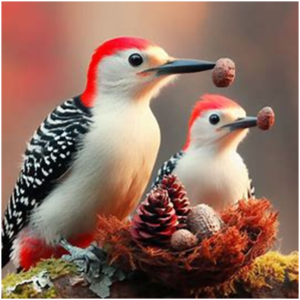Title: Red-Headed Birds: Exploring Nature’s Vibrant Avian Treasures
Introduction:
Red-headed birds stand out as captivating symbols of nature’s diversity and beauty. In this comprehensive exploration, we delve into the unique characteristics, behaviors, and conservation status of these charismatic avian species. From the significance of their fiery plumage to their vital roles in ecosystems, join us on a journey through the fascinating world of red-headed birds.
Defining Red-Headed Birds:
Red-headed birds are characterized by their striking crimson, scarlet, or orange plumage on their heads, setting them apart from other avian species. This distinctive coloration serves various purposes, including mate attraction, species recognition, and communication within their habitats.
Importance of Red Coloration:
The vibrant red coloration of these birds plays a crucial role in mate selection and territorial displays. It serves as a visual signal of health, vitality, and genetic fitness, enhancing their chances of successful reproduction and survival in competitive environments.
Distribution Across the Globe:
Red-headed birds inhabit diverse ecosystems worldwide, from temperate forests to tropical rainforests and grasslands. Species like the Northern Cardinal thrive in North America, while the Red-Headed Woodpecker can be found across North America and parts of Europe. The Scarlet Tanager, known for its vibrant plumage, migrates between North and South America, adding to the global diversity of red-headed avifauna.
Species of Red-Headed Birds:

Among the myriad of red-headed birds, several species stand out for their unique characteristics and ecological significance.
Northern Cardinal: With its vibrant red crest and melodic song, the Northern Cardinal is a beloved resident of North American forests and urban areas. Males boast striking crimson plumage, while females exhibit subtler hues of brown and red.
Red-Headed Woodpecker: Known for its distinctive black-and-white plumage and bright red head, the Red-Headed Woodpecker is a masterful acrobat, effortlessly navigating tree trunks in search of insects and larvae.
Scarlet Tanager: Sporting brilliant scarlet plumage, the Scarlet Tanager is a migratory songbird that breeds in North America and winters in South America. Its melodious song and vibrant appearance make it a sought-after sight for birdwatchers.
Physical Characteristics of Red-Headed Birds: Red-headed birds exhibit a diverse range of physical traits, from plumage coloration to size and shape variations.
Plumage Coloration: The intense red hues of their heads contrast sharply with the muted tones of their bodies, creating a visually stunning display that aids in species recognition and mate attraction.
Size and Shape Variations: Red-headed birds vary in size and shape, with some species, like the Northern Cardinal, being relatively small and compact, while others, such as the Red-Headed Woodpecker, have robust bodies and sturdy beaks adapted for drilling into wood.
Unique Behavioral Traits:

Red-headed birds display a wide array of behaviors that contribute to their ecological roles and survival strategies.
Mating and Breeding Habits: During the breeding season, male red-headed birds engage in elaborate courtship displays to attract mates. These displays often involve vocalizations, territorial behaviors, and impressive aerial maneuvers.
Feeding Preferences and Foraging Techniques: Red-headed birds have diverse diets that may include seeds, insects, fruits, and nectar. The Red-Headed Woodpecker, for example, uses its strong beak to drill into trees and extract insects and larvae, while the Northern Cardinal forages on the ground for seeds and grains.
Vocalizations and Communication:
Red-headed birds use a combination of vocalizations and body language to communicate with conspecifics and other species. Their songs, calls, and displays serve various purposes, including mate attraction, territorial defense, and warning of predators.
Conservation of Red-Headed Birds:
Despite their beauty and ecological importance, red-headed birds face numerous threats to their populations, including habitat loss, climate change, and predation.
Threats to Population Survival: Habitat destruction and fragmentation pose significant threats to red-headed birds, limiting their access to food, nesting sites, and breeding grounds. Climate change exacerbates these threats by altering the availability of food and disrupting migration patterns.
Conservation Initiatives and Success Stories: Conservation organizations and agencies are working tirelessly to protect red-headed bird species and their habitats. Initiatives such as habitat restoration, captive breeding programs, and public awareness campaigns have yielded positive results in safeguarding these avian treasures.
Ways to Contribute to Conservation Efforts:
Individuals can play a vital role in the conservation of red-headed birds by supporting habitat preservation efforts, participating in citizen science projects, and advocating for policies that protect biodiversity. By adopting bird-friendly practices in their communities and educating others about the importance of conservation, individuals can make a meaningful impact on the survival of red-headed bird species.
Conclusion:
Red-headed birds enrich our lives with their beauty, songs, and ecological contributions. By understanding and appreciating these avian treasures, we can ensure their continued survival for future generations to enjoy. Let us join hands in protecting and preserving the vibrant world of red-headed birds for the benefit of all living beings.
With this comprehensive exploration, we hope to inspire a deeper appreciation and understanding of red-headed birds and their importance in our natural world.

